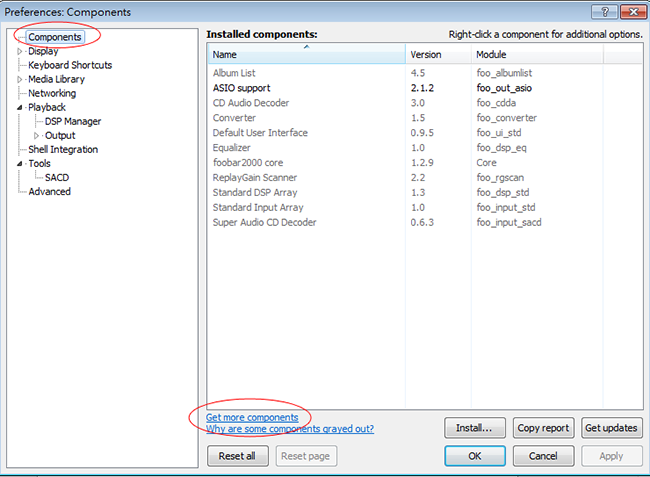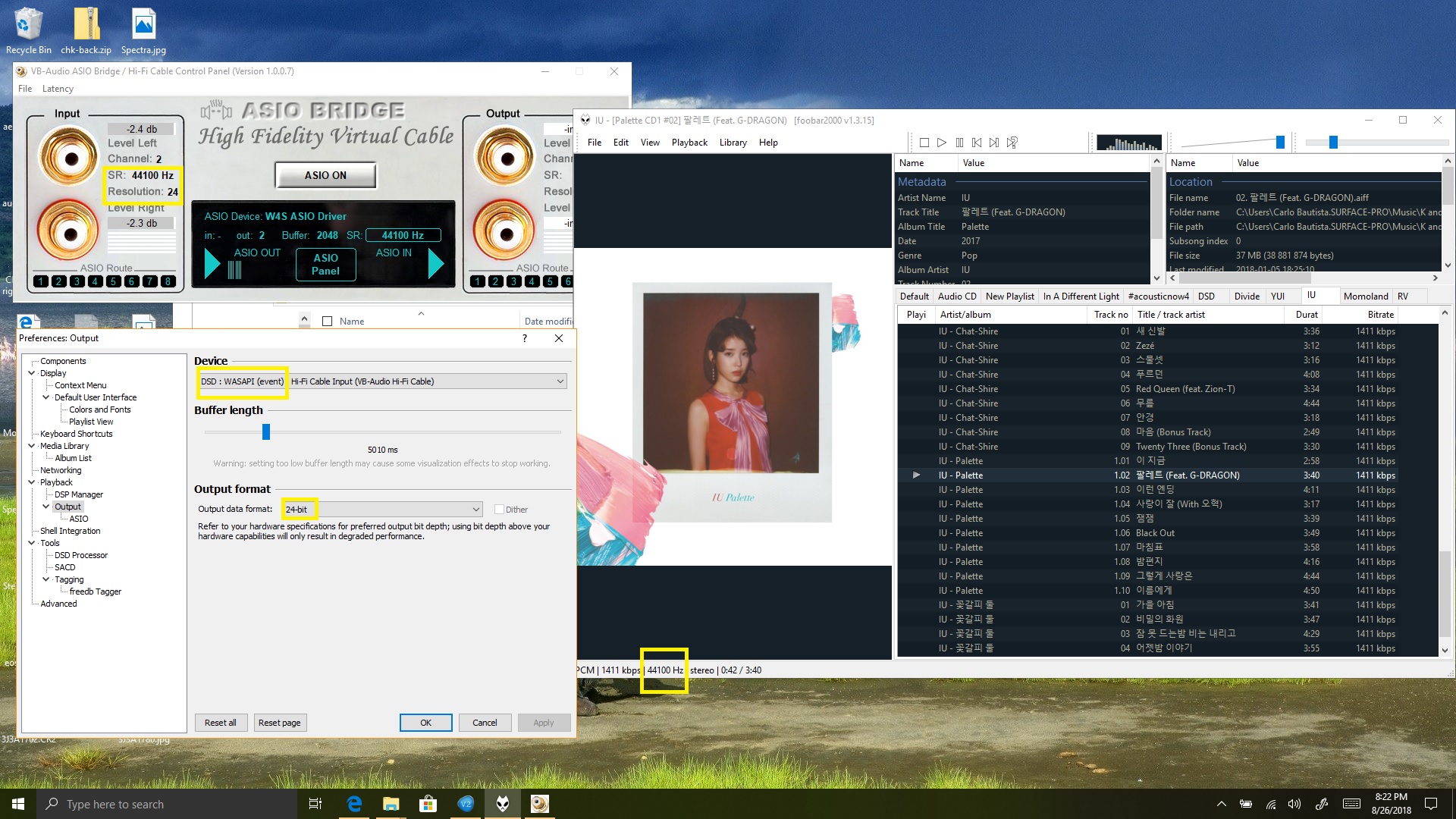Foobar Asio Driver
Audio Stream Input/Output, or ASIO, mode ensures your PC sound doesn’t undergo digital signal processing or sample-rate conversion. It is nearly 100% true to its source, and preferred by audiophiles looking for complete fidelity.
Foobar Asio Drivers
The Foobar2000 version of Headphone EQ can send the sweep sound to a conventional Windows driver only, not ASIO. I believe that your MOTU set includes conventional Windows drivers and you can temporarily use them to make the correction curve. After that you can use Foobar2000 to work with your ASIO drivers. The ASIO driver for the USBPre 2 allows for low-latency operation and sample rates up to 192 KHz on Windows computers. This driver supports Windows XP, Vista, 10, 8, and 7, both 32- and 64-bit versions.
Essence products support native Audio Stream Input/Output 2.2 drivers, known as ASIO 2.2., allowing digital signals to bypass Windows audio layers to avoid redundant processing. With easy setup, it allows you to quickly enjoy high fidelity and stable bit-perfect audio.
*ASIO protocol developed by Steinberg Media Technologies GmbH
The example below shows how to configure your Windows 7 PC with an Essence USB DAC using ASIO as the output mode through the foobar2000 media player:
With the nano or micro iDSD or Retro Stereo 50, with Foobar2K, one must install the DSD SACD/ input and ASIO output plug-ins to enable it to play true native DSD. This step-by-step guide ensures your computer audio program is configured to natively CODE DSDDE for full native playback. Foobar2K is open-source. Workaround for a bug in the Windows 8/8.1 Bluetooth audio driver (causing BSOD when device is opened twice). This bug seems to have been fixed in Windows 10. Improvement: UI response time and driver (re-) start time should be a lot snappier now. Fix: Some Application Verifier errors should be gone. ASIO is a professional level audio driver for Windows. ASIO usually allows you to set lower buffer sizes, and therefore reduce latency. ASIO performance is generally much better, resulting in less audio dropouts and other artefacts. ASIO drivers are usually not included on Windows by default and need to be installed separately. If you are using.
- Install your Essence USB audio product
Please follow the quick-start guide to install the Essence USB audio 2.0 driver and the Essence product. Make sure the Essence product is set as default audio device.
- Install foobar2000
Once foobar2000 is installed, add the ASIO plug-in on foobar2000 — like this:
Step 1: Download the ASIO component
Find the ‘Get more components’ link under File>Preferences>Components – it’s near the bottom of the dialog box
Clicking the link will direct you to www.foobar2000.org/components. Download the ASIO support file and save it to your PC
Step 2: Install the ASIO component
Return to File>Preferences>Components and click the ‘Install’ button
Select ‘foo_out_asio’ component and click the ‘Open’ button
Click ‘Apply’ and restart foobar2000.
Step 3: Enable ASIO output mode
Select ‘ASIO: Essence device’ under Preferences>Output>Playback>Output.Click the ‘Apply’ button and then click ‘OK’.
ASIO audio output is now enabled. Most Essence USB audio products feature a bit-perfect LED indicator. It will always light up under ASIO playback to show that your playback is bit-perfect.
| foobar2000 Preferences | |
|---|---|
Deprecated pages
| |
Output Device[edit]
Controls the physical device that played audio stream is sent to. Commonly available options include:


- Null Output - does nothing; useful mainly for development/testing purposes.
- DS : Primary Sound Driver - your system default DirectSound audio playback device as configured in Windows Sound control panel.
- DS : <device name> - a specific DirectSound audio playback device. What it says depends on what devices you have installed.
Additional output devices can be added using optional output components, such as foo_out_wasapi for WASAPI output (low-latency feed to a sound driver in exclusive mode, bypassing the Windows mixer).
Buffer Length[edit]
To protect playback from glitches during heavy system load or file access lag, resource-heavy operations such as decoding and DSP are always performed ahead of currently heard sound (this is not unique to foobar2000, all or nearly all media players behave this way). This setting controls the distance between decoding/DSP and output.
- High buffer sizes offer stronger protection against glitches but introduce side effects such as long delay between changing DSP settings (eg. adjusting equalizer bands) and changes in sound output.
- Low buffer sizes allow faster responses to DSP configuration changes at cost of higher risk of stuttering during high system load / file access lag / etc.
WARNING: Setting too low buffer length may cause certain visualizations to stop working correctly. Use of buffer lengths below 500ms is not recommended.
Output Format[edit]
Controls the audio data format passed to the operating system / audio drivers / etc. You should refer to your soundcard's documentation to find the optimal setting; using bit depth higher than supported by your hardware might work but will not improve output audio quality in any way and may degrade performance.
Note that this option is not available with some output modes such as ASIO - ASIO architecture doesn't support variable data formats by design, the format that needs to be sent is determined by the driver.

Dither[edit]
This checkbox controls whether to add dither when playing audio that's encoded at a higher bit depth than the chosen output format.
Dither is quiet broadband noise which is added in a manner intended to mask quantization noise, which is the distortion which is sometimes audible when playing digital audio at a lower bit depth than the original. By exploiting a feature of human hearing—the ability to distinguish signal from background noise—dither preserves the higher bit-depth signal within the confines of the lower bit-depth format. This gives the signal greater dynamic range than the lower bit depth allows, and can be perceived as improved, smoother sound quality, but it always comes at the price of added background noise—which, when audible, sounds like tape hiss. However, dither can be 'shaped' to make it avoid lower frequencies, making it less audible to humans.
Dither uses extra CPU power, and generally isn't necessary. The signal in most recorded audio is well within the 96 dB limit of 16-bit, and the distortion introduced in 24-to-16-bit conversion is so quiet as to almost always be masked by the signal, at least for human hearing. Nevertheless, if your soundcard can only handle a maximum of 16-bit input, but you tend to play, at loud volume, 24-bit audio files with very quiet sections that have no background noise, then you may want to enable dither, because it can make those extreme quietest parts of the audio audible, with the addition of hiss.
For a dramatic demonstration of the effect of dither, set the output format to 8-bit (if your soundcard supports it), and play an ordinary 16-bit audio file both with and without dither. The version with dither will have a fair amount of extra noise, but it will be substantially less fuzzy/gritty than the version without. This is an exaggerated demonstration, because for the average human listener, the distortion that occurs when reducing the depth to 8-bit is far more noticeable than that which occurs when down-converting to 16 or 24 bit.
Fading[edit]
This section appears when a DirectSound device is selected.
Without fading, transitions can be jarring when jumping from one track to the next, or when seeking within a track. This section allows this effect to be softened.
Foobar Asio Driver Download
The sliders adjust the fade in and fade out values or the currently selected type of fade (pause & stop, seek within a track, manual track change, automatic track change). Arrow keys may allow the sliders to be adjusted with greater precision than a mouse or touch surface.
